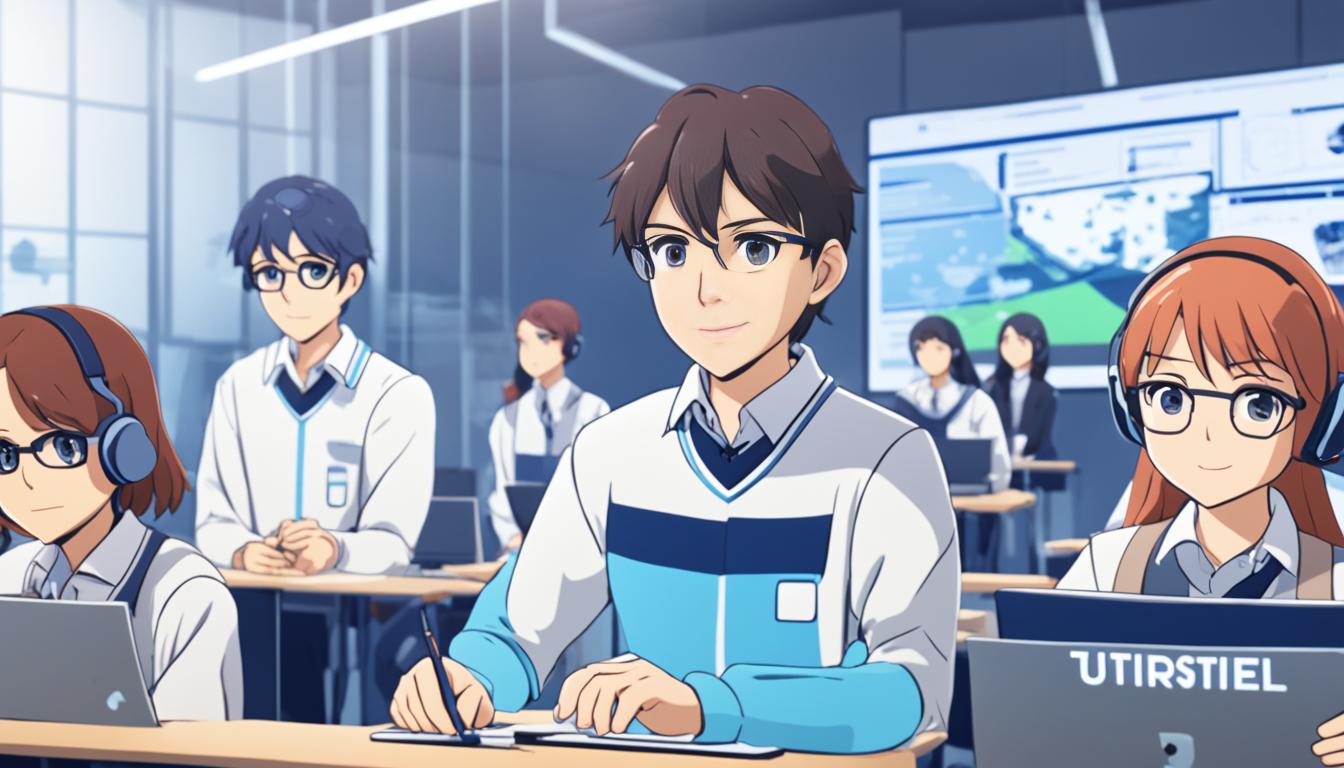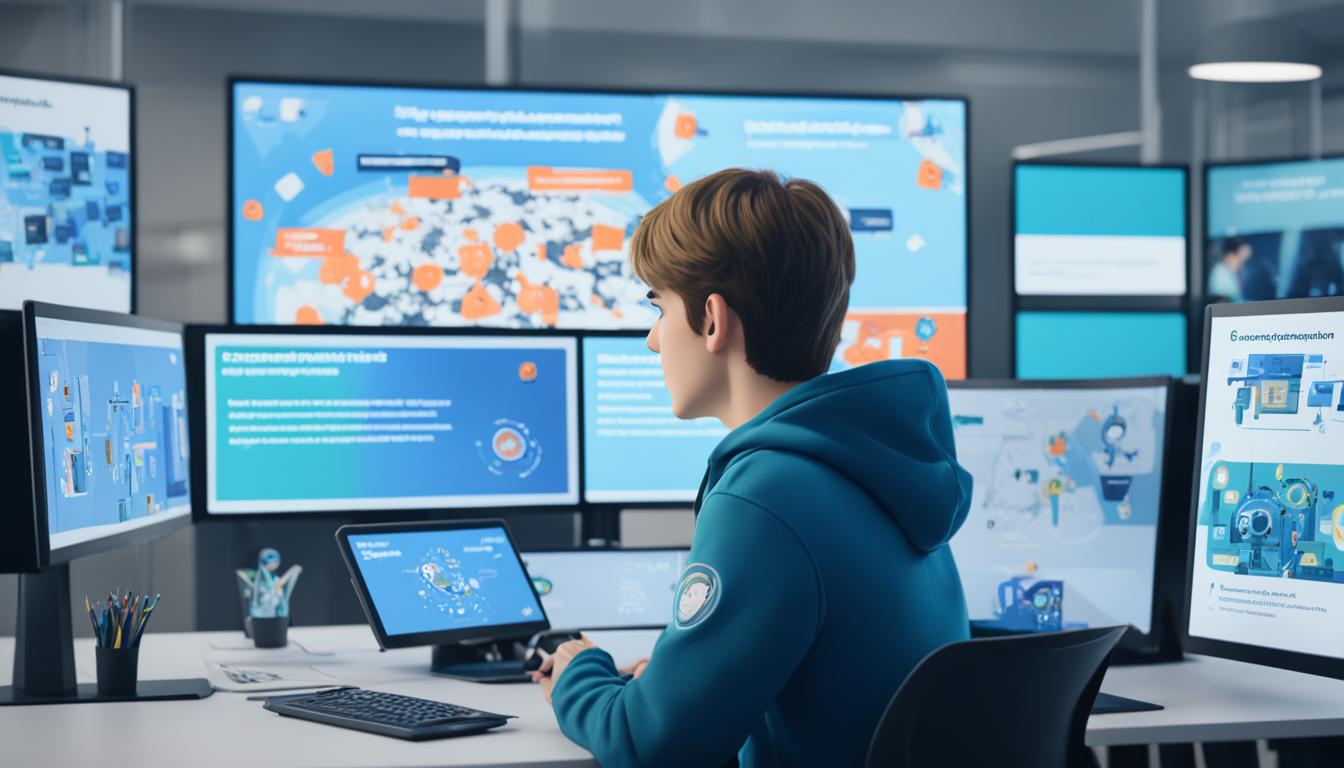
“Education is the most powerful weapon which you can use to change the world.” – Nelson Mandela
In this 21st century, the way we learn is changing fast thanks to new tech. By 2025, education will look very different, with cool gadgets like virtual classrooms and AI teachers. These changes promise to make learning more fun and engaging than ever before.
AI tools will make learning smarter by creating paths that fit each student uniquely. They’ll use data to tailor how they teach based on what you understand best. This will make learning fairer and easier for everyone. The goal, say experts, is to make learning feel more personal, even in a high-tech environment.
Key Takeaways
- Virtual classrooms and AI tutors are central to the future of learning in 2025.
- Educational technology drives personalized learning paths based on individual needs.
- AI in education enhances student engagement and refines teaching methodologies.
- Data-driven insights from AI promote educational equity and accessibility.
- Experts predict a more connected and immersive virtual learning environment.
The Transformative Power of Virtual Classrooms
Virtual classrooms are changing how we learn, using AI to offer personalized education. They use smart algorithms and many tools to adapt to what each student needs. Logos Learning, for example, shows how this works. They help create AI that tailors lessons for every student, matching their learning speed and level.

Personalized Learning Experiences
Personalized teaching is at the center of new educational tech. It uses artificial intelligence to figure out the best way each student learns. So, whether students need to see, hear, or do something to understand, AI makes sure they get it. By doing this, it keeps students interested and active in learning.
Accessibility and Flexibility
Now, learning remotely makes education open to all, no matter one’s income or where they live. Thanks to tech, teachers reach more students with high-quality lessons. This approach lets anyone join in, making learning more open than before. Data supports that these online platforms help everyone have a chance to learn.
AI Tutors: Intelligent Guidance Systems
AI tutors are changing how we learn, using advanced technology to tailor learning to each student. By combining the latest tech with educational innovation, they offer personalized help. This kind of customized support is a game-changer for education by meeting every student’s unique needs.
How Intelligent Tutoring Systems Work
Intelligent Tutoring Systems use AI to look at how students are doing and adjust lessons. They change what and how they teach based on how each student is learning. This approach ensures every student gets help when they need it, making learning more effective and fun.
Benefits of Tailored Mentorship
AI tutors offer more than just personalized learning. They let students learn at their own speed, making sure they really understand topics before moving on to harder things. This method caters to different learning styles, making education more open and available to all.
Thanks to AI, teachers can understand how students learn best, leading to better academic results for everyone. This creates a fairer educational space, supporting all students in their learning journey.
Education in 2025: What to Expect
By 2025, the way we learn will change a lot. New tech will be everywhere in our education, bringing exciting changes. We can look forward to using interactive learning platforms that feel personal. These platforms will use cool simulations and new ways to learn, making studies more fun and useful.
Imagine learning with Virtual Reality (VR) and Augmented Reality (AR). They will let us learn as if we are really there, improving how we pick up skills. This will make learning hands-on and less about just reading and listening. So, we’ll finally get to mix the classroom with the real world.
Helping everyone learn will be another big goal. This means supporting students’ mental health and making sure all kids have what they need to succeed. Using tech this way shows how much we care about giving every student a chance to learn well. It’s a big step towards making education fair for everyone, under the idea of academic innovation.
The integration of VR and AR will offer unparalleled experiences in education, allowing students to engage in lifelike simulations and practices.
Soon, we’ll see more cool tech in education. Tech that changes and learns with us, making every student’s learning unique. Let’s see what this bright future holds:
| Key Aspect | Anticipated Evolution by 2025 |
|---|---|
| Interactive Learning Platforms | Advanced personalization, immersive simulations, competency-based learning |
| Immersive Technologies (VR/AR) | Realistic skill practices, in-person learning environments replication |
| Student Mental Health Services | Integrated support systems within educational tech |
| Educational Equity | Global accessibility to quality education |
As we move ahead to 2025, education will keep on changing, growing, and using the latest in technology. This journey is all about making learning more exciting and available to everyone.
Immersive and Gamified Learning Environments
Immersive learning and gamified methods have changed how we teach. They use tech to make a curriculum that’s fun and keeps people interested. It makes learning more interactive and personal, driving motivation.
Integrating AI in Gamification
When AI is used in gamification, learning becomes a unique experience. It makes games adjust to the way each student learns. This means every student gets a path that’s made just for them, boosting how much they enjoy learning and remember what they’ve learned. AI makes sure the learning journey changes as students get better, always fitting what they need.
Enhancing Student Engagement
Enhancing engagement with AI is about more than just teaching; it’s about creating real immersive experiences using VR and touch tech. These tools offer realistic simulations, helping students build real skills for their future jobs. The result is a curriculum that students find interesting and that really involves them, changing how we view education.
AI in Communication: Bridging Gaps in Virtual Classrooms
The education world is changing fast, and AI is helping. It makes communicating in virtual classrooms better. Thanks to Natural Language Processing (NLP), students and teachers can understand each other more easily. This tech makes learning more open and geared toward everyone’s needs.
The Role of NLP
NLP makes hard info simpler for students to get. AI chatbots and helpers break down tough topics quickly. They answer questions fast, so learning is always moving forward.
These tools can also talk with students in their own language. This breaks the language barrier, making everyone feel included. Think of it as a friend who knows hundreds of languages.
Improving Student-Teacher Interaction
AI tools are changing how students and teachers team up. With instant feedback, teaching becomes a two-way street. Even in a virtual class, it feels like a lively discussion, not a lecture.
Teachers use these tools to spot what each student needs and provide that help. This personal touch makes lessons more supportive and on point for everyone.
Benefits of Real-time Transcriptions
AI offers live text of what’s being said, a big help for many. People with hearing trouble or in noisy places can still follow the lesson. Also, real-time translations help those who don’t speak the lesson’s main language.
This makes sure no one falls behind. All students can get as much from the class as anyone else, thanks to AI.
FAQ
What advancements are shaping education in 2025?
In 2025, we will see more virtual classrooms and AI tutors in education. They will make learning more personal and fair. Thanks to AI, learning is becoming more fun and easy to access for everyone.
How are virtual classrooms transforming the learning experience?
Virtual classrooms use AI and data analysis to offer personalized teaching. It helps each student learn at their own pace and level. This makes learning fair and accessible to all, no matter where they are or their background.
What are Intelligent Tutoring Systems (ITS) and how do they work?
ITS are smart systems that use AI to help students learn better. They look at each student’s data to offer learning that fits them. This means each student gets a special kind of teaching that meets their needs.
What benefits do AI tutors offer?
AI tutors help improve subject understanding and allow flexible learning. They guide each student in a personalized way, leading to better academic results. This kind of teaching makes learning more effective and enjoyable.
What can we expect from the education sector in 2025?
In 2025, education will be very personalized and immersive. It will involve using technologies like VR and AR for learning. The goal is to make learning feel real and to focus on practical skills. These changes will help students learn better and take care of their mental health.
How is AI being used in gamified learning environments?
AI makes game learning more personal by adapting to how each student learns. This boosts learning interest and remembering what’s been learned. With VR and touch technology, students feel like they’re really learning, making lessons stick better.
What role does natural language processing (NLP) play in virtual classrooms?
NLP helps students understand better in virtual classrooms by providing text and speech help. For example, chatbots and translation features make talking between teachers and students easier. This makes lessons more open to everyone, no matter their language.
How does AI improve student-teacher interaction in virtual classrooms?
AI makes talking in virtual class smoother by giving instant text of what’s said. It helps with learning languages and makes talking easier for everyone. This moves learning closer to how it is in a real classroom.
What are the benefits of real-time transcriptions in virtual classrooms?
Real-time text helps students understand lessons better and keep up. It’s good for learning other languages and makes learning welcoming for everyone. Students can always look back at what they learned, making lessons clearer.
